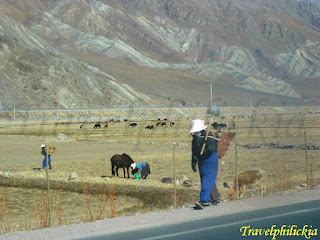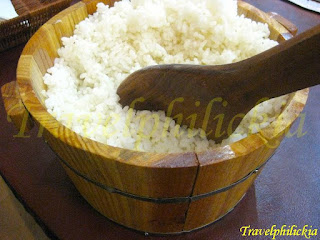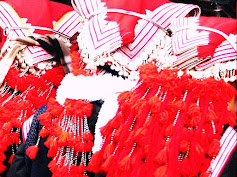After breakfast at the hotel, we then set off at 9 am to Yangbajain Geothermal Field.
Sceneries along the route
Beautiful sceneries consist of steppe and mountainous landscape were observed during the journey (photos below).



 With some luck, the Qinghai-Tibet railway could be spotted running out from the tunnel (left photo below). While most of time the rail tracks were seen without any train (right photo below). Only less than 20 trains arrive and depart daily from Lhasa Terminal Train Station, so it was rare to see Qinghai-Tibet railway trains running on tracks.
With some luck, the Qinghai-Tibet railway could be spotted running out from the tunnel (left photo below). While most of time the rail tracks were seen without any train (right photo below). Only less than 20 trains arrive and depart daily from Lhasa Terminal Train Station, so it was rare to see Qinghai-Tibet railway trains running on tracks.

 Farmers were busy ploughing the fields as it was sowing season (photos below).
Farmers were busy ploughing the fields as it was sowing season (photos below).

 Herd of goats crossed slowly and almost blocked the road, but they dispersed straight away to the road side once our vehicle was near (photos below).
Herd of goats crossed slowly and almost blocked the road, but they dispersed straight away to the road side once our vehicle was near (photos below).

 After an hour's drive, we reached the Yangbajain Geothermal Field.
After an hour's drive, we reached the Yangbajain Geothermal Field.Yangbajain Geothermal Field (羊八井地热田)
Yangbajain Geothermal Field is located approximately 87-km north-west of Lhasa. It is located in a plateau basin on southern slops of the Nyenchen Tanglha Mountains where the Qinghai-Tibet railway passes through Yangbajain.
A power plant harnessing the thermal energy was spotted besides the resort (photos below). These power plants have been developed and used to produce half the electricity for Lhasa and areas nearby.

 Yangbajain Hot Spring Resort (羊八井温泉宾馆)
Yangbajain Hot Spring Resort (羊八井温泉宾馆)Yangbajain Hot Spring Resort is a resort located on the Yangbajain Geothermal Field (photos below).

 After gotten the admission ticket from our tour guide (photo below), we then started our visit in this resort.
After gotten the admission ticket from our tour guide (photo below), we then started our visit in this resort.
Yangbajain Hot Spring Resort consists of indoor and outdoor swimming pools. For indoor pools, there are a large swimming pool (left phot below) and several smaller medicinal pools (right photo below).

 As the underground water temperature is too high, therefore it needs to pass through two outdoor reservoirs for cooling before pumping into pools for visitors to bath in (photos below). The steaming water vapor did make visitors feel like in a fairyland.
As the underground water temperature is too high, therefore it needs to pass through two outdoor reservoirs for cooling before pumping into pools for visitors to bath in (photos below). The steaming water vapor did make visitors feel like in a fairyland.

 Around the large outdoor pool, visitors can see snow-capped mountains from a distance, and taking bath in such an environment is a kind of enjoyment (photos below).
Around the large outdoor pool, visitors can see snow-capped mountains from a distance, and taking bath in such an environment is a kind of enjoyment (photos below).

 At the south side of the resort, the majestic Nyenchen Tanglha Mountains (念青唐古拉山) can be seen (photos below).
At the south side of the resort, the majestic Nyenchen Tanglha Mountains (念青唐古拉山) can be seen (photos below).

Our tour guide then brought us to an area near the outdoor reservoir where some chicken eggs were soaked in (left photo below). Similar to eggs cooked in hot springs, the egg whites was very milky and soft, while the yolk was firm and creamy (right photo below).


Lunch
We then had lunch in a restaurant inside the resort (left photo below). A total of five dishes with vegetarian soup were served in this restaurant together with rice (right photo below).

 After lunch, we were then transferred back to Lhasa.
After lunch, we were then transferred back to Lhasa.Jokhang Temple (大昭寺)
The Jokhang Temple is a Tibetan Buddhist temple in Barkhor Square (photos below) which Tibetans consider this temple as the most sacred and important temple in Tibet.

 During the 7th century, King Songtsen Gampo built both temples, namely Jokhang (大昭寺) and Ramoche (小昭寺) temples. Ramoche Temple is second only to Jokhang Temple in religious importance in Tibet, and is often called "Little Jokhang Temple". It is located about a kilometer from the Jokhang in North Lhasa City.
During the 7th century, King Songtsen Gampo built both temples, namely Jokhang (大昭寺) and Ramoche (小昭寺) temples. Ramoche Temple is second only to Jokhang Temple in religious importance in Tibet, and is often called "Little Jokhang Temple". It is located about a kilometer from the Jokhang in North Lhasa City.Jokhang was originally built to house the statue Jowo Mikyö Dorje (释迦牟尼八岁等身像) brought to Tibet by Princess Bhrikuti (尺尊公主) from Nepal, while Ramoche was to house the statue Jowo Shakyamuni (释迦牟尼十二岁等身像) brought to Tibet by Princess Wencheng (文成公主) from China. Both princesses were on the occasion of their marraige to King Songtsen Gampo. After Songsten Gampo's death, Queen Wencheng moved the statue of Jowo Shakyamuni to Jokhang temple to secure it from an attack. Many years later the Jowo Mikyö Dorje was moved to Ramoche temple. Since then, the statues were swappped in both temples.
 |
As part of the extension in 2000, Jokhang temple has been added to the same list with the Potala Palace as UNESCO World Heritage Site. |
The Jokhang temple covers an area of 2.51-hectares with brick-lined floors, columns and door frames and carvings made of wood. Its architecture features the Tibetan Buddhist style, with influences from China, Indian vihara design and Nepal (photos below).

 The main hall is four storeys high, and there are annex halls on both edges of the courtyard (photos below). The layout and structure reproduce the ideal model of the universe of the mandala in Buddhism.
The main hall is four storeys high, and there are annex halls on both edges of the courtyard (photos below). The layout and structure reproduce the ideal model of the universe of the mandala in Buddhism.

 The rooftop and roof ridges are covered with gilded bronze tiles, figurines and decorated pavilions (photos below).
The rooftop and roof ridges are covered with gilded bronze tiles, figurines and decorated pavilions (photos below).

 Among the iconic statues is the Golden pair of kneeling deer flanking a Dharma wheel (photos below).
Among the iconic statues is the Golden pair of kneeling deer flanking a Dharma wheel (photos below).

 Legend has it that there is a mythical beast with a golden thousand-horned wheel and it prayed for the Buddha Sakyamuni to preach the scriptures and spread the Dharma. When Buddha Sakyamuni preached according to its wishes, the golden gazelles and deer in the forest all came to listen. Thus, this image had been used to decorate the roof of the Tibetan monasteries.
Legend has it that there is a mythical beast with a golden thousand-horned wheel and it prayed for the Buddha Sakyamuni to preach the scriptures and spread the Dharma. When Buddha Sakyamuni preached according to its wishes, the golden gazelles and deer in the forest all came to listen. Thus, this image had been used to decorate the roof of the Tibetan monasteries.In the main hall on the ground floor is a gilded bronze statue of Jowo Sakyamuni, 1.5 metres tall, representing the Buddha at age of twelve. The image has a bejeweled crown, cover around its shoulder, a diamond on its forehead and wears a pearl-studded garment (left photo below). Flanking the main hall are halls dedicated to gods and bodhisattvas, including Avalokiteshwara, Amitabha, Maitreya, Tsong Khapa (right photo below) and Guru Rinpoche.


Outside the temple, it is common sight to see pilgrims prostrate themselves in front of the Jokhang before approaching the main deity inside the temple (photos below). Some of the pilgrims even crawl a considerable distance before reaching the main shrine.


Barkhor Street (八廓街道)
Barkhor Street is an area consisting of a public square and several narrow streets surrounding the Jokhang Temple (photos below). Reputed as the "Heart of Lhasa", it is the most famous pilgrimage circuit and bustling bazaar in Lhasa.

 Roaming around the street, visitors will be fascinated by the various kinds of traditional Tibetan costumes and exotic handicrafts from Nepal, India, Bhutan and surrounding countries (photos below). Besides, the best Lhasa restaurants and mouth-watering food can be found hidden in Barkhor Streets, such as tea, eat local yogurt, potato and beef rice.
Roaming around the street, visitors will be fascinated by the various kinds of traditional Tibetan costumes and exotic handicrafts from Nepal, India, Bhutan and surrounding countries (photos below). Besides, the best Lhasa restaurants and mouth-watering food can be found hidden in Barkhor Streets, such as tea, eat local yogurt, potato and beef rice.

 Retail Store Visit
Retail Store VisitAfter strolling at Barkhor Street, we were brought to a Tian Zhu (天珠), or Dzi Beads, store "Shengbaoyuan Geological and Mineral Exhibition Hall" (圣宝缘地质矿产陈列厅). Following some brief introduction to these Dzi beads, we were free to browse the various bead stones and necklaces. The Dzi bead is considered to provide positive spiritual benefit to owner.
Next, we were then brought to a Tibetan Tea Garden (茶马古道藏茶苑) for some visit (left photo below). There were Tibetan Tea and some snacks for sale (right photo below).

 Dinner
DinnerWe were then transferred to a restaurant "小万湿地鱼庄" (left photo below) for dinner. Interestingly, rice was served in a traditional wooden tub (right photo below).

 Three dishes together with a soup were next served (photos below).
Three dishes together with a soup were next served (photos below).



 Tibetan Cultural Show
Tibetan Cultural ShowThe Tibetan Opera Art Center (藏戏艺术中心) is designed in Tibetan style covering an area of 13,727 square meters (left photo below). The center includes a large auditorium for large-scale Tibetan opera performance (right photo below).

 Wanted to have in-depth understanding on Tibetan culture, therefore we decided to watch the Thangka-style show "Happiness on the Way" (幸福在路上) performed at the centre. The show cost RMB 280 per person at our own expense. Similar to the admission of Jokhang, the ticket also had the 3D effect (photo below).
Wanted to have in-depth understanding on Tibetan culture, therefore we decided to watch the Thangka-style show "Happiness on the Way" (幸福在路上) performed at the centre. The show cost RMB 280 per person at our own expense. Similar to the admission of Jokhang, the ticket also had the 3D effect (photo below).
The scene began with finding the gate of Shambhala or happiness (photos below).

 Next Act was on "Water – seeking for happiness" (photos below). In Tibet, water runs out from snow mountains and life comes from water. Thus, happiness comes out from life.
Next Act was on "Water – seeking for happiness" (photos below). In Tibet, water runs out from snow mountains and life comes from water. Thus, happiness comes out from life.

 Act 2 on "Soil – promising happiness" (photos below). Tibetan begin to sew the seeds of hope and happiness under bright spring sunlight.
Act 2 on "Soil – promising happiness" (photos below). Tibetan begin to sew the seeds of hope and happiness under bright spring sunlight.



 Act 3 on "Wind – taking happiness" (photos below). Plateau wind is fresh and cool, blowing nomadic songs away with the gentleness of the moon and passion of the river.
Act 3 on "Wind – taking happiness" (photos below). Plateau wind is fresh and cool, blowing nomadic songs away with the gentleness of the moon and passion of the river.





 Final Act 4 on "Fire – choosing happiness" (photos below).
Final Act 4 on "Fire – choosing happiness" (photos below).




Night Scene of Potala Palace
After the show, we requested to visit the Potala Palace to take photos of its night scene. Almost the same as I saw in the internet, the palace was beautifully lit with lights at night (photos below).

 We left after taking the photos and reached the hotel at about 10.30 pm.
We left after taking the photos and reached the hotel at about 10.30 pm.
 Posts RSS
Posts RSS





